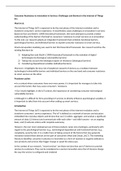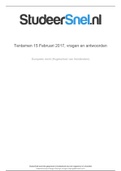Consumer Resistance to Innovation in Services: Challenges and Barriers in the Internet of Things
Era
Mani et al.
The Internet of Things (IoT) is expected to be the next phase of the Internet revolution and to
transform consumers’ service experience. It nevertheless raises challenges on innovation in services.
Based on Ram and Sheth’s (1989) theoretical framework, this work attempts to provide a better
understanding of the barriers that lead to consumers’ resistance to smart services as an innovation.
To this end, our research adopts an integrative framework that combines functional barriers,
psychological barriers, and individual barriers to explain consumer resistance to smart services.
Structural equation modeling was used to test this theoretical framework. Our research enriches the
existing literature by
1) Adapting Ram and Sheth’s (1989) theoretical framework to the evolution of digital
technologies (technological vulnerability barriers)
2) Taking into account the ideological aspect of resistance (ideological barriers)
3) Considering dispositional variables (individual barriers).
Moreover, it highlights the key role of skepticism toward IoT devices as a mediator between
technological vulnerability barriers and individual barriers on the one hand and consumer resistance
to smart services on the other.
Practioner points
• In a context where consumers have ever more power, it is important for managers to take into
account the factors that may cause consumers’ resistance.
• Our results highlight, in the IoT context, the importance of considering consumer technological
vulnerability barriers.
• Although it is difficult for firms providing IoT services to directly influence psychological variables, it
is important to take them into account when setting up smart services.
Introduction
The Internet of Things (IoT) is expected to be the next phase of the Internet revolution and to
transform consumers’ service experience. The IoT is defined as a network of sensors and actuators
embedded into everyday objects and devices that can (1) collect, aggregate, and analyze a significant
amount of data; (2) interact and communicate with each other—and with humans—on an ongoing
basis; and (3) activate actions with complete autonomy
However, the ever more widespread use of these products raises new challenges, particularly with
regard to the psychological barriers (e.g., technological dependence) and functional barriers (e.g.,
complexity, security risk). It is a matter here of taking account of the factors that may generate
resistance toward these devices on the part of consumers (Mani and Chouk, 2017). The marketing
literature identifies consumer resistance to innovation as a form of reaction or negative attitude to
new products and services that trigger change or upset the status quo.
In the context of our research, “smart services” are those services that use IoT devices to provide
services to customers. They can be considered as a service innovation since the IoT devices change
the way the service is configured and rendered
, Consequently, to ensure the success of these new services, it is important for companies to analyze
the potential resistance factors
From a theoretical standpoint, the current literature is deficient in at least four respects. First,
despite the importance of services in the global economy, innovation studies tend to focus on
products rather than services
Second, the introduction of IoT devices into services changes the way these services are delivered
and conceived
Third, the majority of existing research on innovation in services concentrates on success factors and
the adoption process
Ostrom, and Brown, 2005, p. 61). Finally, the majority of marketing research on innovation resistance
is based mainly on Ram and Sheth’s (1989) theoretical model. This model has been continuously used
and tested in different contexts (e.g., the Internet and mobile banking [Laukkanen, 2016], smart
products [Mani and Chouk, 2017]). However, this model suffers from two limitations. On the one
hand, according to Heinze, Thomann, and Fischer (2017), this model is based on past concepts that
need to be adjusted in the digital age.
To fill these theoretical gaps, the objective of this study is to provide a better understanding of the
drivers of consumer resistance to smart services. In particular, the research aims at extending Ram
and Sheth’s (1989) theoretical framework with regard to the barriers that lead to the rejection of
innovations.
Hence, our paper will attempt to answer the following question: To what extent do psychological,
functional, and individual barriers impact consumer resistance to smart services?
This new way of benefiting from service can be considered as an innovation, as defined by Rogers
(1995, p. 11): “an innovation is an idea, practice, or object that is perceived as new by an individual
or other unit of adoption.” Thus, a smart service may be perceived by consumers as something
In marketing, the literature that explains the consumer response to innovation recognizes two
research paradigms (Laukkanen, 2016): (1) innovation adoption and (2) resistance to innovation
For Ram (1987), however, “innovation resistance is not the obverse of innovation adoption.”
Consequently, the adoption of an innovation is conditioned by the overcoming of consumers’ initial
resistance. Hence, resistance and adoption can coexist during the life of the innovation and can be
explained by similar factors
Consumer resistance is a particular form of resistance to change caused by innovation
Ram (1987) proposes a model of innovation resistance with three categories of determinants of
resistance to innovation: (1) perceived innovation characteristics (e.g., complexity, perceived risk,
communicability), (2) consumer characteristics (e.g., personality, motivation, self-confidence,
previous innovative experience), and (3) characteristics of propagation mechanisms (e.g., credibility,
clarity, informativeness).
In their model, Ram and Sheth (1989) identify two categories of barriers to explain consumers’
resistance to innovation: (1) functional barriers and (2) psychological barriers. Functional barriers
arise “if consumers perceive significant changes from adopting the innovation”
Era
Mani et al.
The Internet of Things (IoT) is expected to be the next phase of the Internet revolution and to
transform consumers’ service experience. It nevertheless raises challenges on innovation in services.
Based on Ram and Sheth’s (1989) theoretical framework, this work attempts to provide a better
understanding of the barriers that lead to consumers’ resistance to smart services as an innovation.
To this end, our research adopts an integrative framework that combines functional barriers,
psychological barriers, and individual barriers to explain consumer resistance to smart services.
Structural equation modeling was used to test this theoretical framework. Our research enriches the
existing literature by
1) Adapting Ram and Sheth’s (1989) theoretical framework to the evolution of digital
technologies (technological vulnerability barriers)
2) Taking into account the ideological aspect of resistance (ideological barriers)
3) Considering dispositional variables (individual barriers).
Moreover, it highlights the key role of skepticism toward IoT devices as a mediator between
technological vulnerability barriers and individual barriers on the one hand and consumer resistance
to smart services on the other.
Practioner points
• In a context where consumers have ever more power, it is important for managers to take into
account the factors that may cause consumers’ resistance.
• Our results highlight, in the IoT context, the importance of considering consumer technological
vulnerability barriers.
• Although it is difficult for firms providing IoT services to directly influence psychological variables, it
is important to take them into account when setting up smart services.
Introduction
The Internet of Things (IoT) is expected to be the next phase of the Internet revolution and to
transform consumers’ service experience. The IoT is defined as a network of sensors and actuators
embedded into everyday objects and devices that can (1) collect, aggregate, and analyze a significant
amount of data; (2) interact and communicate with each other—and with humans—on an ongoing
basis; and (3) activate actions with complete autonomy
However, the ever more widespread use of these products raises new challenges, particularly with
regard to the psychological barriers (e.g., technological dependence) and functional barriers (e.g.,
complexity, security risk). It is a matter here of taking account of the factors that may generate
resistance toward these devices on the part of consumers (Mani and Chouk, 2017). The marketing
literature identifies consumer resistance to innovation as a form of reaction or negative attitude to
new products and services that trigger change or upset the status quo.
In the context of our research, “smart services” are those services that use IoT devices to provide
services to customers. They can be considered as a service innovation since the IoT devices change
the way the service is configured and rendered
, Consequently, to ensure the success of these new services, it is important for companies to analyze
the potential resistance factors
From a theoretical standpoint, the current literature is deficient in at least four respects. First,
despite the importance of services in the global economy, innovation studies tend to focus on
products rather than services
Second, the introduction of IoT devices into services changes the way these services are delivered
and conceived
Third, the majority of existing research on innovation in services concentrates on success factors and
the adoption process
Ostrom, and Brown, 2005, p. 61). Finally, the majority of marketing research on innovation resistance
is based mainly on Ram and Sheth’s (1989) theoretical model. This model has been continuously used
and tested in different contexts (e.g., the Internet and mobile banking [Laukkanen, 2016], smart
products [Mani and Chouk, 2017]). However, this model suffers from two limitations. On the one
hand, according to Heinze, Thomann, and Fischer (2017), this model is based on past concepts that
need to be adjusted in the digital age.
To fill these theoretical gaps, the objective of this study is to provide a better understanding of the
drivers of consumer resistance to smart services. In particular, the research aims at extending Ram
and Sheth’s (1989) theoretical framework with regard to the barriers that lead to the rejection of
innovations.
Hence, our paper will attempt to answer the following question: To what extent do psychological,
functional, and individual barriers impact consumer resistance to smart services?
This new way of benefiting from service can be considered as an innovation, as defined by Rogers
(1995, p. 11): “an innovation is an idea, practice, or object that is perceived as new by an individual
or other unit of adoption.” Thus, a smart service may be perceived by consumers as something
In marketing, the literature that explains the consumer response to innovation recognizes two
research paradigms (Laukkanen, 2016): (1) innovation adoption and (2) resistance to innovation
For Ram (1987), however, “innovation resistance is not the obverse of innovation adoption.”
Consequently, the adoption of an innovation is conditioned by the overcoming of consumers’ initial
resistance. Hence, resistance and adoption can coexist during the life of the innovation and can be
explained by similar factors
Consumer resistance is a particular form of resistance to change caused by innovation
Ram (1987) proposes a model of innovation resistance with three categories of determinants of
resistance to innovation: (1) perceived innovation characteristics (e.g., complexity, perceived risk,
communicability), (2) consumer characteristics (e.g., personality, motivation, self-confidence,
previous innovative experience), and (3) characteristics of propagation mechanisms (e.g., credibility,
clarity, informativeness).
In their model, Ram and Sheth (1989) identify two categories of barriers to explain consumers’
resistance to innovation: (1) functional barriers and (2) psychological barriers. Functional barriers
arise “if consumers perceive significant changes from adopting the innovation”



